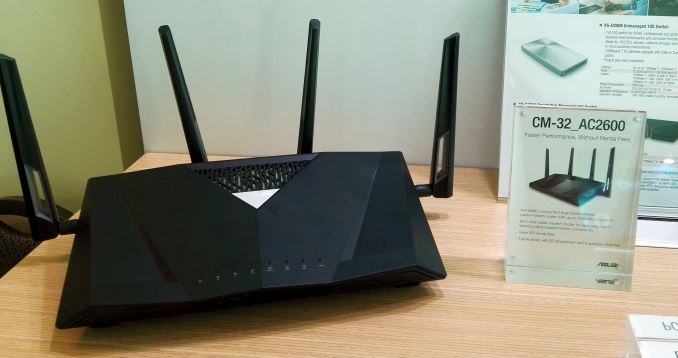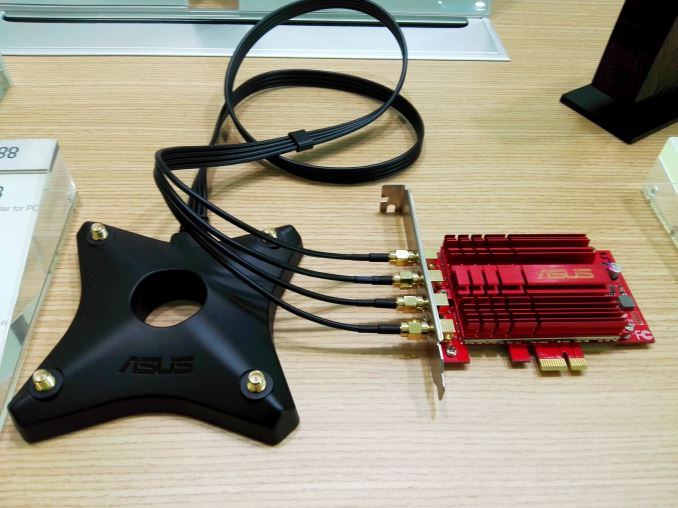ASUS Booth Tour at CES 2016: 10G Switches, External GPU Dock, USB-C Monitor and more
by Ian Cutress on January 19, 2016 9:00 AM ESTAside from the 10GBase-T switches written about earlier (they were actually hidden more in the B2B part of ASUS’ booth complex), the march on wireless is still one of ASUS’ marketing angles. Anyone who has looked into new routers or WiFi connection points can’t help but have noticed the swathe of ASUS routers now available, from single stream 802.11n USB sticks all the way up to 4x4 dual band 802.11ac MU-MIMO capable hardware.
Networking
ASUS had on display the AC2600 cable modem router, which offers 4x4 MIMO support, which can provide better coverage than the current generation of 3x3 models. I find it mildly interesting that it lists up to 2.53 Gbps support, although this will be shared between connected units and the gigabit Ethernet network ports on the rear might be a bottleneck to peak speed. That being said, the only time peak speed would be needed is for file transfer or multiple streaming.
To go with this, because there are no 4x4 on-motherboard solutions currently out, ASUS also had a PCIe wireless networking card which supports 4x4 802.11ac for up to 3.1 Gbps theoretical speed.
ASUS put a big heatsink on this card to help it keep cool under load, and the unit is massive. That being said, similar to other ASUS units, it is magnetic and thus will allow most users to affix it to the top or side of the PC chassis. Ultimately this is aimed at being the peak solution for when wires can’t make it.
Also on display was what ASUS was calling the first USB 3.0 based dual-band AC1900 WiFi point, capable of 3x4 MIMO and a flexible cable. In the USB format, this can be moved from machine to machine as well as not taking up a PCIe 3.0 x1 port on the motherboard. No word on pricing or release date at this time.













50 Comments
View All Comments
randomhkkid - Tuesday, January 19, 2016 - link
The ROG GX700 dock only contains radiators and pumps, the 980 laptop gpu is housed in the laptop itself. http://core0.staticworld.net/images/article/2015/1...hechacker1 - Tuesday, January 19, 2016 - link
That's a good start for a 10G switch, but it really needs more 10G ports to be useful. I deploy 10G all the time for my job, and we use the Intel X520, which is a generation behind, but stable as a rock and supported everywhere. It also can be found for relatively cheap (sometimes $250). At those prices it almost makes sense to build your own "switch" by just using 10G cards and directly connecting where you need it. I know in my environment I really only need 10G to my NAS, and then 10G to the workstation for media / VMs.BrokenCrayons - Tuesday, January 19, 2016 - link
A Cherry Trail phone with 4GB of RAM and 256GB of storage for $350 sounds great. Now if only a certain software company that makes operating systems would be kind enough to stop it with the silly pricing that keeps budget laptops with Cherry Trail processors chained to half that much RAM and 1/8th of the storage. >.<Pissedoffyouth - Tuesday, January 19, 2016 - link
Why the hell do they have to make a retarded version of the zenphone with bigger battery. Give me the atom version with 5000mah battery and I'll pay good money for itcfineman - Tuesday, January 19, 2016 - link
So when is that gsync monitor coming out? Seems like's it's been vaporware for a while... are they trying to work out the of the QC issues Acer has been dealing with or...???CaedenV - Wednesday, January 20, 2016 - link
@Ian, I am also excited that 10/t is finally coming to the consumer market! I have a NAS, and constantly have to move around ISOs and uncompressed video files/projects between my main PC and my NAS. Thankfully I get a solid 98-102MB/s... but the idea of being able to get 980MB-1GB/s sounds too good to be true! I mean, a Windows ISO would take a mere 10 secconds to transfer... heck at those speeds just use the NAS like a local HDD and write straight to and from it without ever transferring to a local disc!Thankfully for me though, the rest of my family is quite alright with gigabit Ethernet and WiFi, so having only 2 10Gb/s connections is not a bad limitation for me. They need to bring the price down a bit more before I'll bite though. $200 for an unmanaged switch with 2 10Gb/s ports and 4 1Gb/s ports, and $75-100 for each card. Still, I could see it being something when I do my next big build in a few short years.
... now if only they can do something about my 25mbps internet conneciton and 5mbps uplink...
sor - Wednesday, January 20, 2016 - link
The switches are underwhelming. We've had affordable switches with a few 10g + a bunch of 1g for awhile.10g baseT has been a pretty epic failure so far. I managed to find a 48 port Dell 3 years ago, pretty much the only full 10G baseT available, and it was so power hungry that it couldn't keep more than 24 ports running at once. They took it back, then discontinued the line. SFP+ and twinax for cheap copper interconnects worked much better.
merikafyeah - Wednesday, January 20, 2016 - link
10GbaseT is actually a mandatory part of the Thunderbolt 3 spec, so a TB3 (USB Type-C) switch could finally bring affordable 1GB+/s transfers to consumers.noeldillabough - Wednesday, January 20, 2016 - link
Will 10G work reliably over Cat6/6a? Or do we need to use Cat7/8 etc?sor - Thursday, January 21, 2016 - link
6a is the standard for 10g baseT. There are other types floating around like 6e, 7, 7a, etc, but none are standards based, mostly marketing.